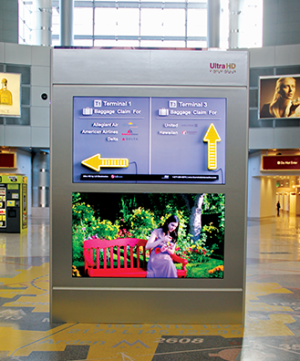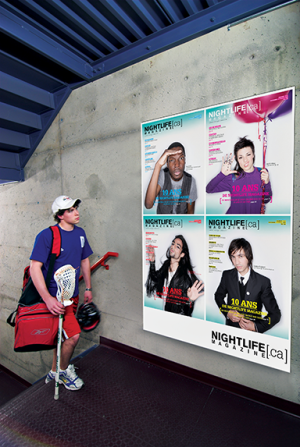The groundwork for this market trend was laid in 2013, when the first 4K digital signage was installed for a wayfinding system in McCarran International Airport in Las Vegas, Nev., followed by panels in Delta Airlines’ passenger lounges in other U.S. airports (see Sign Media Canada, November 2013, page 35). At the same time, technology firms began to unveil UHD-compatible content management software and media players.
Even as more 4K installations reach price-sensitive digital signage markets and content is repurposed from the consumer market, however, such panels will constitute a mere drop in the bucket compared to the overall UHD market. Shipments of UHD TVs, by way of comparison, were expected to reach 10 million units in 2014 and 40 million by 2018.
Many of the panel manufacturers, including LG, Samsung and Sony, are the same for both markets. IHS suggests this could muddle the distinction between consumer- and commercial-grade displays, which may be problematic given the specific requirements of the digital signage industry in terms of hardware and software for disseminating content.

The first 4K digital signage system was installed in February 2013 at McCarran International Airport in Las Vegas, Nev., in time to welcome visitors to that year’s Digital Signage Expo (DSE).
Other obstacles include infrastructure and investment costs associated with upgrading digital signage networks, the requirement for additional bandwidth to support 4K content and the need to harmonize specifications for frame rates, brightness, dynamic range and other metrics that could be affected by resolution upgrades.
Further, IHS reports specialized screen manufacturers in the digital signage industry are facing a challenge from less expensive, consumer-grade TV panels. The company suggests the global signage and professional displays market would continue to see relatively flat revenues unless the industry can change some of its current dynamics. Overall revenue in 2014 was forecast to reach $13.76 billion, down from the 2012 total of $14 billion and up slightly from $13.58 billion in 2013. More significantly, no revenue projections from 2015 to 2018 exceed figures for 2014, despite a steady rise in screen shipments.
“The future for display vendors is going to be challenging,” says Sanju Khatri, IHS’s director of digital signage and professional video. “The industry faces tough competition as commercial establishments begin to use ordinary consumer TVs as replacements for specially outfitted digital signage displays.”
Educating buyers is paramount, Khatri says, since conventional TVs are not equivalent to the large-format liquid crystal display (LCD) panels designed for commercial signage use. Commercial-grade panels are built for longer wear, enclosed in metal chassis for improved heat dissipation and outfitted with special backlighting modules to ensure image clarity even under vivid ambient lighting. Some are also loaded with media players, sensors, touch interface modules and digital signage software.
Consumer TVs, on the other hand, are not designed for 24-7 use and will wear out much more quickly. They also cannot be joined together relatively seamlessly to form video walls.
So, despite the sobering market forecast, digital signage panel manufacturers can capitalize on premium features like high brightness, ultra-narrow bezels, interactivity and ultra-high-definition (UHD) resolution. The retail industry, by way of example, understands the value of digital signage and continues to represent a sizable market opportunity.
To further distance their products from conventional TVs, IHS suggests display manufacturers could team up with other hardware and software vendors to provide ‘all-in-one’ units capable of handling multiple sources of content, integrating with mobile communications and analyzing data.

Large format OOH ads attract a higher degree of attention than many other paid media.
OOH advertising
Behind the market performance of many wide-format printed graphics, illuminated signs and digital displays, of course, lies the strength of the out-of-home (OOH) advertising industry. According to a report conducted for the International Sign Association (ISA) by IHS and Vandiver Associates, for example, growth in the electric signage market in 2015 will largely depend on an estimated 15 per cent increase in OOH revenue.
“Large-format OOH provides huge benefits to brands, which receive a higher degree of attention than through other paid media,” said Carolin Baumann, group marketing director for BlowUp Media, after using eye-tracking technology to examine how people view posters and billboards. “Their sheer size allows images and messages to be communicated with greater emotion, which in turn leads to a more memorable campaign and a higher probability of purchasing an advertising product.”
Another study by Cog Research and psychologist Amanda Ellison combined eye-tracking technology with monitored skin conductance readings from 20 people as they went through their daily lives (see page 62). By matching the skin conductance highs and lows, which can measure emotional responses to external stimuli, to the subjects’ various actions and locations, the researchers ascertained people are 33 per cent more alert to ads when outside their homes.
“This research puts numbers to what we all sense,” said Mike Baker, CEO of the Outdoor Media Centre, an OOH trade organization, “namely that we move around out of home in a sharper and more focused frame of mind. Advertisers can use this ‘active’ space to target consumers at different points in their day.”





